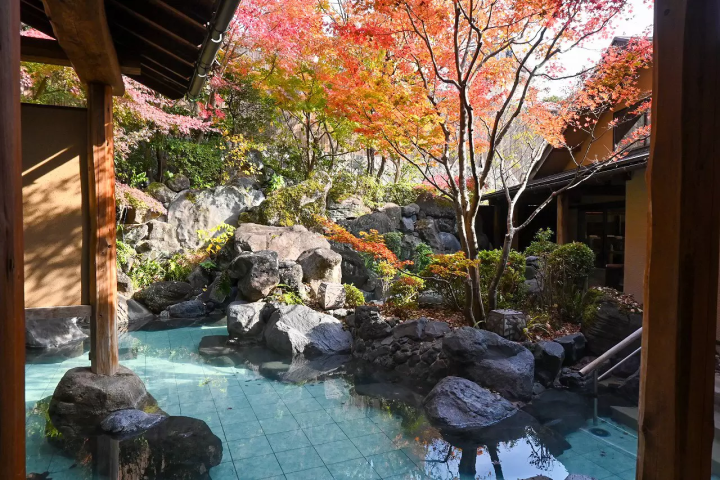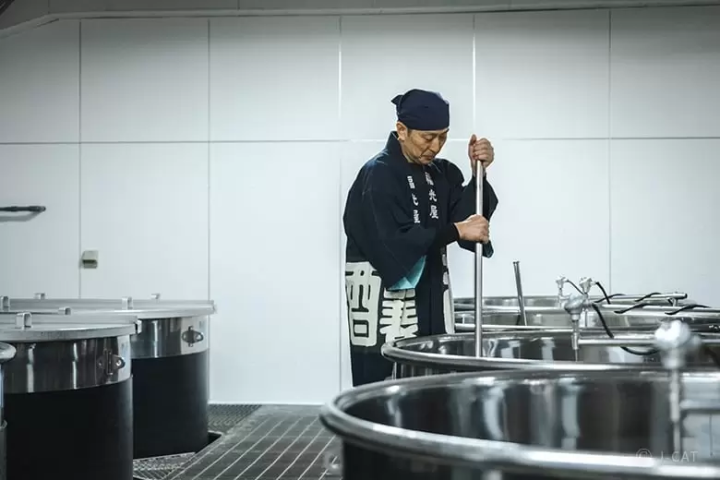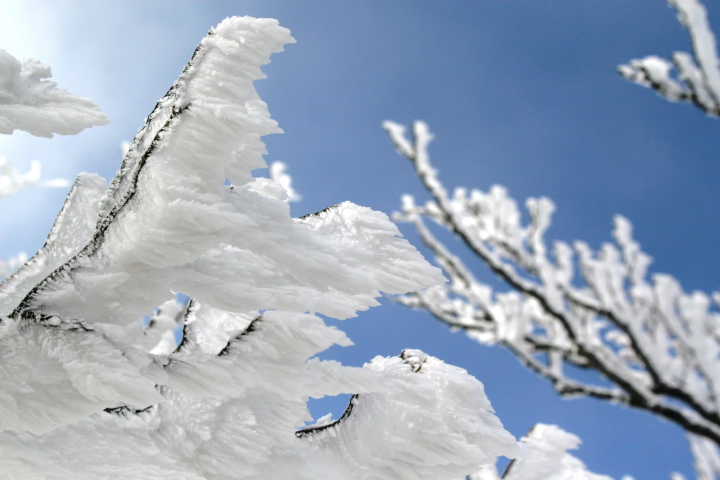Hokuriku Shinkansen Kanazawa-Tsuruga section opens! What is the “Former Hokuriku Line Tunnel Group”, a group of railway remains that spans Tsuruga City and Minamiechizen Town, Fukui Prefecture?

Tsuruga, Fukui Prefecture, known as a city of railways and ports, finally saw the opening of the Hokuriku Shinkansen line in Fukui Prefecture on March 16, 2024. It is the first city on the Sea of Japan coast where a railway was laid, and many railway remains remain to this day, making it popular not only among railway fans but also among road enthusiasts. In this article, we will introduce the "Former Hokuriku Line Tunnels" where you can experience history firsthand. *The spots introduced in ...
-
Table of Contents
- Access to Tsuruga, Fukui Prefecture
- What are the Former Hokuriku Line Tunnels?
- ① Former Hokuriku Line Yamanaka Tunnel
- ②Old Hokuriku Line Habara Tunnel
- 3. Old Hokuriku Line Kashimaga Tunnel
- Former Hokuriku Line Tunnels Area Information
- A new chapter in railway history begins!
- For information about Tsuruga, Fukui Prefecture, please click here.
- For an introduction to Tsuruga's recommended gourmet foods, please click here.
- For an introduction to recommended sightseeing spots in Tsuruga, please click here.
- Please click here for an introduction to a sample sightseeing itinerary for Tsuruga.
- For information about the romantic festival in Tsuruga's famous cherry blossom viewing spot, please click here.
- For an introduction to experiencing Japanese culture in Tsuruga with traditional Japanese clothing and matcha tea, please click here.
Access to Tsuruga, Fukui Prefecture
Tsuruga, Fukui Prefecture, known as a railway and port town, will finally open the Hokuriku Shinkansen in Fukui Prefecture on March 16, 2024. It can be accessed from Tokyo without changing trains. Enjoy sightseeing and local cuisine in Tsuruga, which will now be even more easily accessible.
What are the Former Hokuriku Line Tunnels?
This is a group of railway remains, centered around the tunnels of the former JR Hokuriku Line in Minami Echizen Town, Tsuruga City, Fukui Prefecture. The section from Tsuruga to Fukui was opened in 1896, and was used as a railway line until the opening of the Hokuriku Tunnel in 1962. In particular, 12 tunnels were dug between Tsuruga and Imajo, which are surrounded by rugged mountains and steep slopes, 11 of which still remain today. They have been selected as a civil engineering heritage site by the Japan Society of Civil Engineers and registered as a national tangible cultural property.
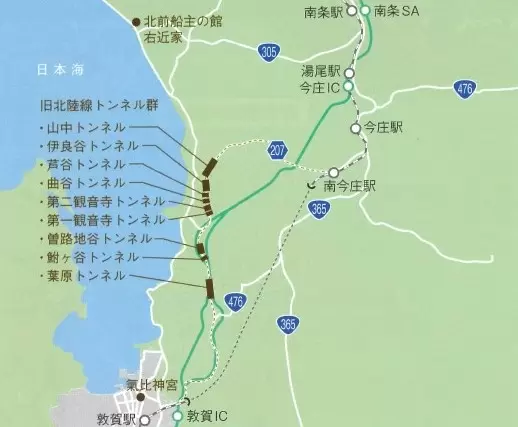
① Former Hokuriku Line Yamanaka Tunnel
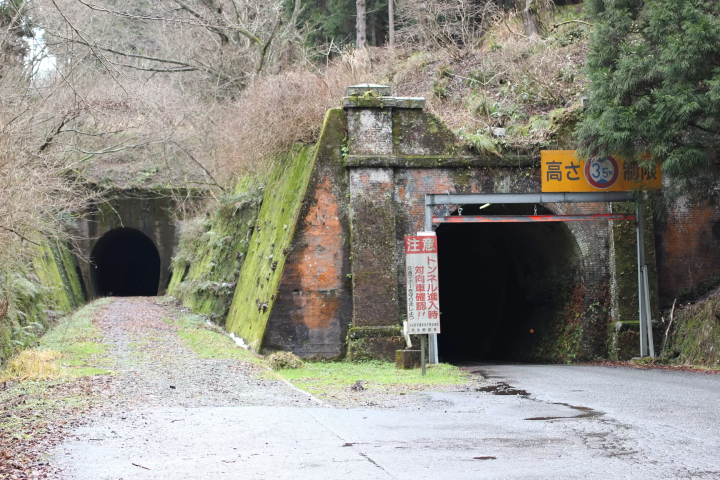
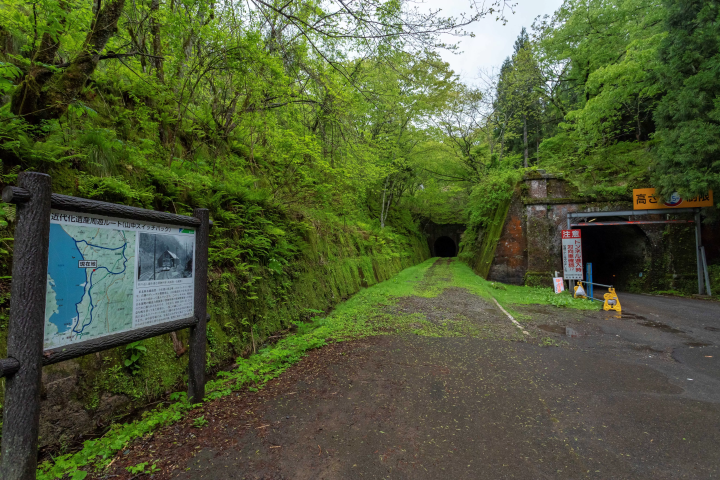
Completed in 1896, it is 1,170 meters long, 3.7 meters wide, and straight. It is a brick tunnel with five arches and a brick entrance. It is one of the largest railway tunnels in Japan, and is known as one of the most difficult construction works, along with the Habara Tunnel on the old Hokuriku Line.
Directions: Approximately 25 minutes by car from Tsuruga IC on the Hokuriku Expressway
②Old Hokuriku Line Habara Tunnel
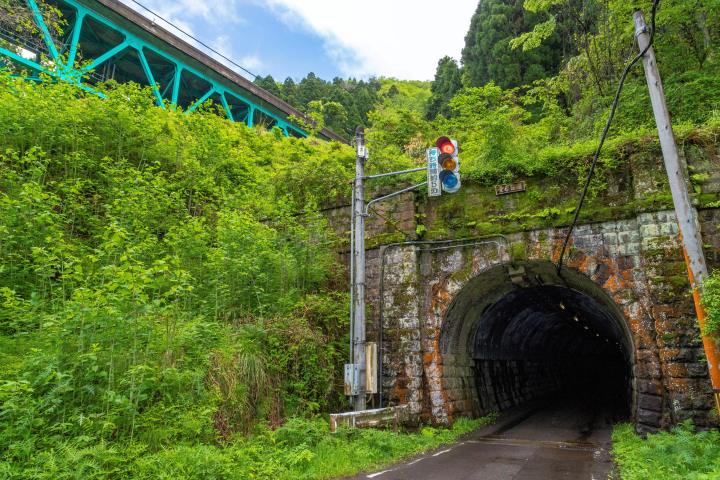
Completed in 1896, this gently curving stone and brick tunnel is 979 meters long and 3.9 meters wide. The entrance is an imposing structure with nearly symmetrical cut stone masonry, wall columns, and long parapets that extend out on both sides. The drainage channels at the back of the entrance and on the wing walls were intricately constructed using cut stone and brick.
Directions
If travelling by car: Approximately 20 minutes by car from Tsuruga IC on the Hokuriku Expressway
If you take the bus: Take the community bus "Togo Line" from JR Tsuruga Station for about 12 to 42 minutes and get off at the "Haba" stop. Then walk for about 25 minutes. *Advance reservations are required to board the "Togo Line." Click here for reservation methods .
By taxi: Approximately 20 minutes by taxi from JR Tsuruga Station
3. Old Hokuriku Line Kashimaga Tunnel
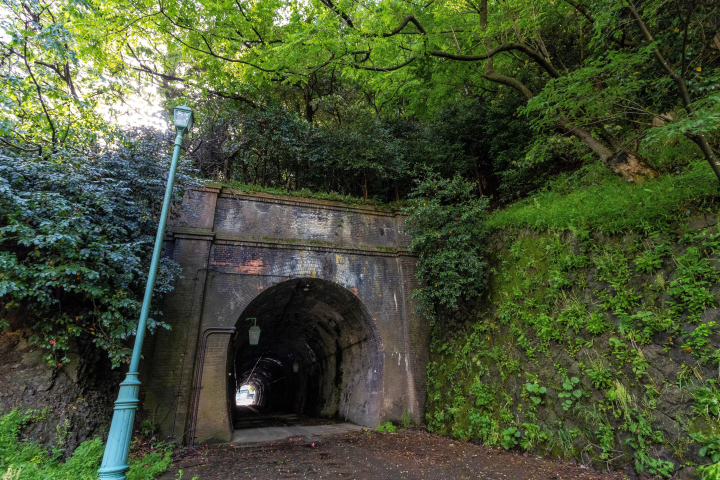
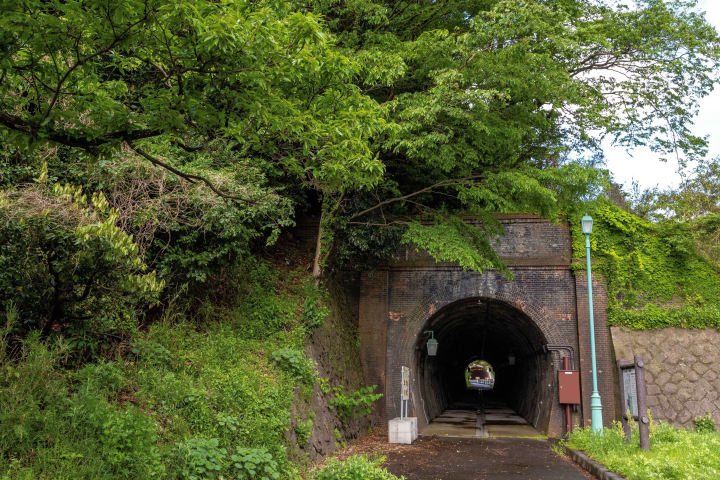
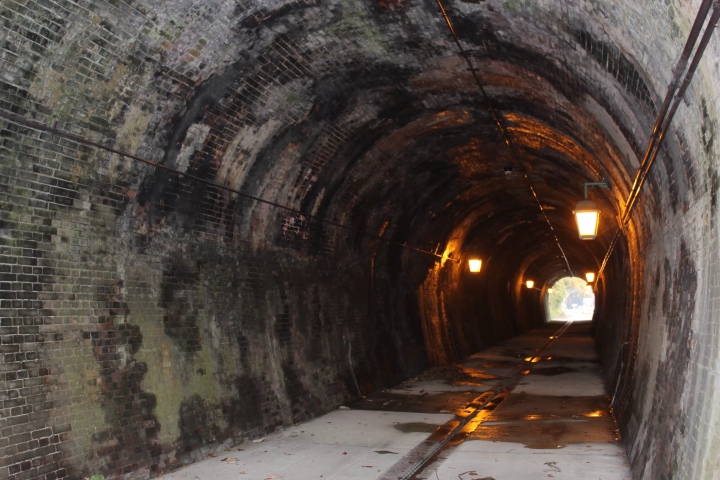
Completed in 1893, it is 87 meters long and 3.9 meters wide, with a straight line. It is characterised by a five-layer lining, built using bricks all the way up to the capstone and bandstone at the entrance.
Directions
If travelling by car: Approximately 10 minutes by car from Tsuruga IC on the Hokuriku Expressway
If you take the bus: Take the community bus "Togo Line" from JR Tsuruga Station for about 12 to 24 minutes and get off at the "Kashimagari" stop. About a 5-minute walk. *Advance reservations are required to board the "Togo Line." Click here for reservation methods .
By taxi: Approximately 10 minutes by taxi from JR Tsuruga Station
Former Hokuriku Line Tunnels Area Information
Meals
"Plat Park Suizu PA Down Line"
The "Yuuhi no Atelier" observation deck is famous as a viewpoint overlooking the magnificent view of Tsuruga Bay, and has been certified as a "Lovers' Sanctuary." Fukui specialties "Echizen Oroshi Soba" and "Sauce Katsudon" are popular.
Sugitsu Parking Area (upbound) is a rare parking area nationwide. In fact, it used to be a train station, not a parking area, and is the site of the former Sugitsu Station on the Hokuriku Line. After the line was closed, the station building was reused as a parking area, which is quite moving.
Just a short walk from the back of Sugitsu PA is the former Hokuriku Line Sojidani Tunnel, made of stone and brick.
●Sweets
" Henna Habutae 'Fresh Mochi Pudding' Specialty Store"
A shop located along Route 8 in Tsuruga City, Fukui Prefecture.
This is a direct sales store of "Maeda Seika", a famous shop for Fukui Prefecture's specialty confectionery, Habutae mochi. *Only open on weekends and holidays.
This product is a collaboration between Fukui's specialty "Hantai Mochi" and the local Tsuruga specialty "Higashiura Mikan". "Higashiura Mikan" is produced in the Higashiura area of Tsuruga City, Fukui Prefecture, and is characterized by its moderate sweetness and sourness. In the late 1800s, it was exported overseas from Tsuruga Port as a Tsuruga specialty.
A new chapter in railway history begins!
With the opening of the new line via Omi-Shiotsu in 1957 and the Hokuriku Tunnel in 1962, the Yanagase Tunnel and the tunnel over the mountains were abandoned, but the remains offer a glimpse of the difficult construction work at the time and traces of what was said to be the most difficult railway section in Japan. It is recommended to take a leisurely trip while reminiscing about the past, including Tsuruga, which retains its international city culture, Imajo, a post town on the Hokkoku Kaido road, and Nagahama, a commercial city that flourished as a castle town. With the extension of the Hokuriku Shinkansen to Tsuruga Station in March 2024, why not enjoy a new style of travel while learning about railway history?
For information about Tsuruga, Fukui Prefecture, please click here.
For an introduction to Tsuruga's recommended gourmet foods, please click here.
For an introduction to recommended sightseeing spots in Tsuruga, please click here.
Please click here for an introduction to a model itinerary for sightseeing in Tsuruga.
For information about the romantic festival in Tsuruga's famous cherry blossom viewing spot, please click here.
For an introduction to experiencing Japanese culture in Tsuruga with traditional Japanese clothing and matcha tea, please click here.
On March 16, 2024, the Hokuriku Shinkansen opened between Kanazawa Station and Tsuruga Station. Tsuruga Station will be the terminus from both the Tokyo and Kansai areas, and is attracting a lot of attention. Tsuruga is a city of railways and ports, and the Shinkansen opened in the town where the first railway ran on the Sea of Japan side, so it is popular among people other than railway fans. There are many tourist spots scattered around, and after the opening of the mountain-side Japan Heritage Old Hokuriku Line Tunnels Heritage Group, the direct train "Europe-Asia International Express" ran to Tsuruga Port, which developed into one of the leading international ports on the Sea of Japan side. We will continue to offer route buses and tour plans, such as new tourist routes of Japan Heritage on the sea side along the Tsuruga Port Line. Come and go on a trip with exciting experiences beyond your imagination.
The contents on this page may partially contain automatic translation.


![2024 edition [Tsuruga, Fukui Prefecture] Summary of access methods from Tokyo, Osaka, Kyoto, Nagoya, and Kanazawa to Tsuruga, the "town of railways and ports"](https://resources.matcha-jp.com/resize/200x2000/2023/12/06-155271.webp)
![[2024 Edition] Thorough explanation of access from Tokyo to Tsuruga, Fukui Prefecture. Enjoy the retro charm of Tsuruga, a town of railways and ports!](https://resources.matcha-jp.com/resize/200x2000/2023/12/15-156988.webp)




![[2024] The Hokuriku Shinkansen will open between Kanazawa and Tsuruga on March 16, 2024! Three popular Japanese cultural experiences you can enjoy in Tsuruga, Fukui Prefecture!](https://resources.matcha-jp.com/resize/200x2000/2024/01/17-162503.webp)



![[2025 Edition] A thorough guide to getting to the Echizen Great Buddha(Echizen Daibutsu)](https://resources.matcha-jp.com/resize/720x2000/2023/05/10-137958.webp)
























![[For beginners and debutants] Special feature on recommended ski resorts and ski tours!](https://resources.matcha-jp.com/resize/720x2000/2025/12/26-254120.webp)
